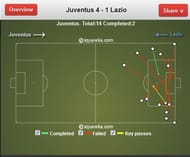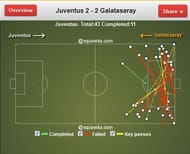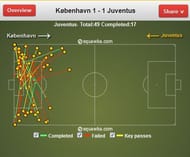Juventus manager Antonio Conte has been busy formulating a new setup for his side to excel in the Champions League this season.
“Bayern are a couple of levels higher in terms of talent, with Robben and Ribery on the flanks compared to, with all due respect, the Bianconeri’s Padoin and Asamoah.”
– Antonio Conte, after losing to Bayern Munich in Champions League quarter-final last season.
Conte delivered a blunt account of the hiding they suffered at the hands of a Bayern Munich side that went on to become the European champions last season. Of course, there is no harm in accepting your shortcomings as a manager, yet Juve’s depleted wing-force is something Conte was surely aware of even before the showdown against the Bavarians.
The Italian manager knew that it would hamper his side’s chances but had no viable option to deploy and a disappointing end result was written all over it. In Padoin and Asamoah, the Bianconeri never had enough to stifle or contain the nippy ‘Robbery’ combo. Add the influential Lahm and a rather flamboyant Alaba, and Juventus were caught in 2v1 losing battles on both flanks. In the end, a 4-0 aggregate loss seemed fitting reflection of the sheer dominance of Jupp Heynckes’s men, compelling Conte to set up a variant for future European assignments.
After winning consecutive league titles and guiding the side on a 49-game unbeaten run, a dream run on the European caravan remains an unfulfilled dream for the Turin giants. Now, with a side synonymous to a well-oiled machine that has been celebrated domestically for some indomitable displays on the football field, Conte needs to take that next step towards major European triumphs. No doubt, tactical makeshifts are required to thrive against the European giants, and with nothing to lose, Conte looks prepared to give it a go.
Conte’s Juventus 2.0 believes in ‘crossing’ the line to fulfil the European dream

Juventus’ conventional style of play fails to yield any kind of threat from the flanks in the Serie A. Image Courtesy: squawka.com
Considering Juventus have preferred to stick religiously to a 3-5-2 formation on their triumphant domestic campaigns, any major change to accommodate width in the play would hinder the inherent stability of the unit – more so if it’s meant for only the Champions League mid-week. Hence, any core change in the playing style has been given its due course of time by Conte.
The manager was prepared for this gradual shift from the outset, and summer signings of the ever-so-adaptive Carlos Tevez and a staunch target man in Fernando Llorente helped in filling the crucial spots in the new blueprint. He also tried to sign Fiorentina’s rampaging Columbian Juan Cuadrado, widely regarded as the best winger in the league, but couldn’t force a move. Be it desperation or a cause of boiling ambition, it was evident that the new Conte was lured towards the more popular 4-3-2-1 setup.
Although Cuadrado didn’t budge, Conte, for now, has restored some faith in Mauricio Isla – a player brought a season ago to add the same direct approach in the Old Lady’s predictably organized ensemble. The result? We’ve started to see the first few glimpses of Conte’s footballing brainchild.
Suddenly, there is a visible contrast in the style of play opted in Serie A and Champions League by Conte. While the domestic juggernaut is still shrugging its opponents on the back of a solid 5-man midfield, the same cannot be said for the European night experiments.
Against Galatasaray on Wednesday, when the Turkish side took the lead in the first half, Conte decided to throw a few surprises in front of a worried home crowd in Turin. In came Isla, Llorente and Quagiarella to overturn the dynamics of an increasingly dull encounter. On the back of a re-jigged 3-4-3-ish setup, the Old Lady attack reinvented a long lost dimension to their game – crossing.
While Juve almost did manage to scamper a win out of nothing, the game deservedly ended at 2-2. More importantly, it saw Juve conjuring a punch-for-punch formula that could well see them scale new heights in the premier competition.
As far as the numbers go, they support Conte’s gradual tinkering on the European front. Take a look at the significant increase in the number of crosses in the two European games as compared to their best domestic performance of the season against Lazio. While Juventus attempted only 14 crosses in their 4-1 win over Lazio in the league, the number rose to 49 in their first European tie in Copenhagen. Another 43 attempts at home against Galatasaray this mid-week after barren spells on the domestic front in the derby against Torino seem like no coincidence either. The intent from Antonio Conte to dissect and make conclusions is there for everyone to see.
So is this slow start to the Champions League a well-mapped experimental move from Conte? Is the luxury of being placed in a relatively comfortable group assisting Juve in changing their core methods on European soil? To be fair, the effects of Conte’s changed outlook does look obvious when you look at the bigger picture. The willingness to slowly incorporate Llorente as a focal figure of the attack, the numerous opportunities given to Isla and Asamoah to succeed and Conte’s own admission at inducing mobility in the midfield (hinting at Pirlo’s departure) speak volumes about things we could expect from the Bianconeri.
Conte’s adaptive width theory: A double-edged sword
The early transitional stages on the Champions League stage may have brought a wobbly start for Juventus, yet things do seem set to pay dividends in the latter stages. The problem lies on the domestic front where week in week out the players have been made to adjust to their more conventional style of play. This brings constant tinkering into the game preparations, rotating squads, and one must admit, an uninvited sense of vulnerability in what has been a dominating unit over the past couple of seasons.
Already we’ve seen Juve conceding early goals on more than a few occasions this season, while goals have also been hard to come by. Four of their five victories have come only by a difference of one goal, and policies will be scrutinized as the season progresses towards its business end.
Yet, the increased width, no matter how much it is disregarded in the current form of Italian style of play, could act as a bail-out weapon against defensive setups that tend to succumb against the aerial threat. Incidentally, Conte’s men will face AC Milan this upcoming weekend who have been struggling to keep out headed goals this season – and it would be interesting to see if it alters Juve’s pre-match dossier for the evening.
All in all, while it might have its own set of issues to be dealt with, Conte’s increased width of European ambitions does open a window of exciting possibilities for the Italian champions.


